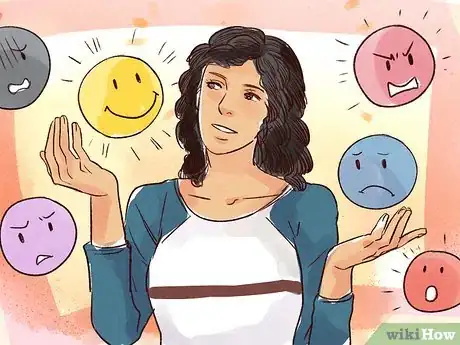This article was co-authored by Chloe Carmichael, PhD. Chloe Carmichael, PhD is a Licensed Clinical Psychologist who runs a private practice in New York City. With over a decade of psychological consulting experience, Dr. Chloe specializes in relationship issues, stress management, self esteem, and career coaching. She has also instructed undergraduate courses at Long Island University and has served as adjunct faculty at the City University of New York. Dr. Chloe completed her PhD in Clinical Psychology at Long Island University in Brooklyn, New York and her clinical training at Lenox Hill Hospital and Kings County Hospital. She is accredited by the American Psychological Association and is the author of “Nervous Energy: Harness the Power of Your Anxiety” and “Dr. Chloe's 10 Commandments of Dating.”
There are 20 references cited in this article, which can be found at the bottom of the page.
wikiHow marks an article as reader-approved once it receives enough positive feedback. In this case, 89% of readers who voted found the article helpful, earning it our reader-approved status.
This article has been viewed 325,554 times.
Emotions are always with us. You might feel happiness when you laugh with a close friend or fear when you approach a growling dog. But there’s more to emotions than just the subjective experience of them. You can also learn how to understand your emotions. In recent years, scientists have increased our knowledge about the nature of emotions—about how different emotions came into existence, how emotions guide our behavior, and how different emotions impact our bodies and minds. Learning to understand your emotions is a fascinating endeavour that can help enhance your control over both your feelings and actions.
Steps
Examining the Nature of Emotions
-
1Understand the origin of emotions. Emotions are programmed responses shaped by evolution. They allow you to navigate your environment in ways that were generally adaptive in the past and are often still adaptive today.[1]
- For example, emotions like fear evolved over time. When our human ancestors, who had the capacity to experience fear, saw a steep cliff, they behaved more cautiously as they neared the precipice. Because they took more precautions, individuals who experienced fear were more likely to survive than those without fear. The fearful individuals lived long enough to reproduce and gave birth to children with a similar capacity for fear.
- Evolution selected for both negative emotions like fear and positive emotions such as happiness. Negative emotions deter individuals away from actions that are harmful or costly. On the other hand, positive emotions motivate people towards potentially beneficial actions.[2]
-
2Know the basic emotions. Most psychologists agree that there are a set of so-called "basic emotions" with which all humans are endowed. These basic emotions are: anger, disgust, fear, happiness, sadness, and surprise.
- Researchers have since expanded the list of emotions to include contempt, pride, shame, love, and anxiety. There may be more basic emotions than that, but the extent to which they are universally experienced or culture-specific remains up for debate.[3]
Advertisement -
3Learn about the role emotions play. Emotions are incredibly important for our survival, our ability to thrive, and our ability to make good decisions. All emotions—even negative ones—help us navigate our world.
- For example, imagine you woke up one day, and you didn't feel embarrassed or have any sense of shame or social anxiety. You generally did not care at all how you acted in front of other people. Chances are you would lose all your friends if you didn't care how you acted around them. That’s because emotions help us to get along with others.[4]
-
4Recognize how emotions affect decision-making. Emotions are critically important to our ability to make decisions. Emotions provide value or weight to some information, thereby biasing our decision-making in one direction or another. Several studies have found that people with lesions to parts of their brain that are involved with emotion have impaired decision-making and in some cases impaired moral behavior.[5]
- The most famous of these cases is Phineas Gage (PG). While working PG was accidentally impaled in the head with an iron rod, damaging a part of his brain involved in the processing of emotion. Miraculously, PG survived the accident, although he was never the same person again. His personality changed drastically. He displayed flat or inappropriate emotion, made horrible decisions, and was miserable to be around. One of the main reasons for this shift in behavior was that the rod had damaged a part of his brain involved in emotion. [6] [7]
- One group that has trouble in society are psychopaths. One of the key diagnostic criterion for psychopathy is a lack of emotion, something called callous-unemotional traits or a lack of empathy or guilt. Lacking these emotions can lead to antisocial and sometimes criminal behavior, highlighting the importance of emotion to our sense of morality.[8]
-
5Know that emotions can become disordered. Just as you could get a disorder of your kidneys or eyes, your emotions can also become disordered. If you think your emotions are potentially disordered, talk to a mental health professional about treatment options. Some of the more common disorders of emotion, or mental disorders in which emotions are affected include:[9]
- Depression, which involves persistent and long-lasting feelings of sadness and a loss of interest.[10]
- Anxiety disorders. General anxiety disorder refers to extended and excessive worry about day-to-day occurrences.[11]
- Schizophrenia can be associated with a lack of emotions or an irritable or depressed mood.
- Mania, which generally occurs in bipolar disorder, refers to an extended period of abnormally and excessively elevated mood. Manic individuals may also be excessively and persistently irritable.[12]
-
6Record when your emotions occur. Once you have a sense of when emotions arise and how they feel, you can take notes on your emotions to further understand them. To learn more about the specific emotions you experience and what triggers them in your life, keep a log of when you feel an emotion and write down what you think triggered it.
- For example, maybe you felt anger and you recalled that soon before you realized that you had to wait in line for 15 minutes for lunch, and you hate waiting in lines.
- You can use this information to increase or decrease the emotions that you want or don't want in your life. If you know what makes you angry, you can take steps to avoid situations that trigger that emotion. For example, once you know that you hate waiting in lines, you can only buy a small handful of groceries at a time, so you can use the express lane.
EXPERT TIPChloe Carmichael, PhD is a Licensed Clinical Psychologist who runs a private practice in New York City. With over a decade of psychological consulting experience, Dr. Chloe specializes in relationship issues, stress management, self esteem, and career coaching. She has also instructed undergraduate courses at Long Island University and has served as adjunct faculty at the City University of New York. Dr. Chloe completed her PhD in Clinical Psychology at Long Island University in Brooklyn, New York and her clinical training at Lenox Hill Hospital and Kings County Hospital. She is accredited by the American Psychological Association and is the author of “Nervous Energy: Harness the Power of Your Anxiety” and “Dr. Chloe's 10 Commandments of Dating.”Licensed Clinical Psychologist
 Chloe Carmichael, PhD
Chloe Carmichael, PhD
Licensed Clinical PsychologistWhen people experience strong, unpleasant emotions, it's natural for them to want to shut those emotions down and avoid them. However, that actually only makes them more emotional and insecure. Instead of ignoring emotions, journal about them or express how you're feeling to a friend. It's ironic, but trying to stifle your emotions will only make them louder and more intense.
Recognizing Your Emotions
-
1Learn what each emotion feels like. People report that different emotions feel different subjectively. While the clearest distinction is that negative emotions feel very different than positive emotions, different negative emotions also feel different from each other. Embarrassment feels different than sadness, which feels different from fear.
-
2Learn what anger feels like. Anger is experienced when someone has wronged you in some way. It serves to dissuade them from doing so again in the future. Without an emotion like anger, people might repeatedly take advantage of you. [13]
- The experience of anger sometimes begins in the back between the shoulder blades and travels upward, along the back of the neck and around the sides of the jaws and head.
- When experiencing anger you may feel hot and flustered.
- If you notice sensations like tension, pain, and pressure in your back, neck, and jaws, you may be internalizing your anger.
-
3Learn what disgust feels like. Disgust is a response toward repulsive stimuli, often things that can make us physically sick. It functions to protect us from things that could make us ill. It can also be experienced when we find things metaphorically gross - like certain moral violations. [14]
- Disgust is felt primarily in the stomach, chest, and head areas of the body. You may actually feel sick or nauseous and find yourself closing off your nasal passages and moving away from the revolting stimuli.[15]
-
4Understand what fear feels like. Fear is experienced in response to dangerous threats like bears, heights, or guns. It helps us to avoid these things in the moment and to learn to avoid them in the future.[16] Although fear is an evolved emotional response, many of the things we are afraid of are learned.
- Fear is usually felt primarily in the top half of the body. However, when it involves a fear of heights, fear often involves sensation in the legs.
- When experiencing fear, your heart may beat faster, you may breathe quicker, your palms may feel sweaty and hot as part of your nervous system kicks into high gear. This response is the so called fight or flight response.
-
5Know what happiness feels like. Happiness is experienced in response to things that often have implications for surviving, thriving, and passing on one's genes. Examples of things that make us happy include having sex, having children, succeeding in a valued goal, being praised by others, and being in a nice welcoming environment. [17]
-
6Review what sadness feels like. Sadness is experienced in response to a loss that we care about. It is a very painful emotion, which may act to help us to avoid losses in the future or to appreciate what we have when we get something back (such as in the case of a romantic partner). [20]
- Sadness often begins in the chest and moves upward through the throat and up to the eyes where we see tears. You've probably heard the expression: "She's all choked up." Allowing yourself to cry fully can be a cleansing experience. Paying attention to the physical sensations in these areas and allowing the energy to move, helps us to grieve after a loss and empathize with others' suffering.[21] [22]
-
7Know what surprise feels like. Surprise is experienced when something is unexpected but not deemed to be a threat. It is an interesting emotion in that it is relatively neutral in valence compared to the other emotions, which are often felt as positive or negative. Surprise may function to help re-orient attention to novel unexpected things. [23]
- Surprise is felt primarily in the head and chest. It is experienced in response to the unexpected; it can feel like a bit of a jolt.[24]
Expert Q&A
-
QuestionHow can I recognize my emotions?
 Chloe Carmichael, PhDChloe Carmichael, PhD is a Licensed Clinical Psychologist who runs a private practice in New York City. With over a decade of psychological consulting experience, Dr. Chloe specializes in relationship issues, stress management, self esteem, and career coaching. She has also instructed undergraduate courses at Long Island University and has served as adjunct faculty at the City University of New York. Dr. Chloe completed her PhD in Clinical Psychology at Long Island University in Brooklyn, New York and her clinical training at Lenox Hill Hospital and Kings County Hospital. She is accredited by the American Psychological Association and is the author of “Nervous Energy: Harness the Power of Your Anxiety” and “Dr. Chloe's 10 Commandments of Dating.”
Chloe Carmichael, PhDChloe Carmichael, PhD is a Licensed Clinical Psychologist who runs a private practice in New York City. With over a decade of psychological consulting experience, Dr. Chloe specializes in relationship issues, stress management, self esteem, and career coaching. She has also instructed undergraduate courses at Long Island University and has served as adjunct faculty at the City University of New York. Dr. Chloe completed her PhD in Clinical Psychology at Long Island University in Brooklyn, New York and her clinical training at Lenox Hill Hospital and Kings County Hospital. She is accredited by the American Psychological Association and is the author of “Nervous Energy: Harness the Power of Your Anxiety” and “Dr. Chloe's 10 Commandments of Dating.”
Licensed Clinical Psychologist Try labeling them. Labeling your emotions will help you be more aware of them and understand them better.
Try labeling them. Labeling your emotions will help you be more aware of them and understand them better. -
QuestionHow would labeling your emotions help you?
 Sandra PossingSandra Possing is a life coach, speaker, and entrepreneur based in the San Francisco Bay Area. Sandra specializes in one-on-one coaching with a focus on mindset and leadership transformation. Sandra received her coaching training from The Coaches Training Institute and has seven years of life coaching experience. She holds a BA in Anthropology from the University of California, Los Angeles.
Sandra PossingSandra Possing is a life coach, speaker, and entrepreneur based in the San Francisco Bay Area. Sandra specializes in one-on-one coaching with a focus on mindset and leadership transformation. Sandra received her coaching training from The Coaches Training Institute and has seven years of life coaching experience. She holds a BA in Anthropology from the University of California, Los Angeles.
Life Coach Tracking your beliefs and thoughts will help you process the way you're looking at the world and feeling about yourself. This way, you can catch any self-judgmental or unproductive thought patterns and start and work on fixing them.
Tracking your beliefs and thoughts will help you process the way you're looking at the world and feeling about yourself. This way, you can catch any self-judgmental or unproductive thought patterns and start and work on fixing them.
Warnings
- If you are experiencing severe and/or extended emotional pain, or are noticing very drastic changes in your mood, see a mental health professional.⧼thumbs_response⧽
References
- ↑ http://www-personal.umich.edu/~nesse/Articles/EvolExplanEmotions-HumNature-1990.pdf
- ↑ http://www-personal.umich.edu/~nesse/Articles/Nesse-Ellsworth-EvolEmotions-AmPsychol-2009.pdf
- ↑ http://www.prevention.com/mind-body/emotional-health/where-your-body-feels-emotions
- ↑ http://www-personal.umich.edu/~nesse/Articles/FeelingGoodBad-Sciences-1991.pdf
- ↑ http://bigthink.com/experts-corner/decisions-are-emotional-not-logical-the-neuroscience-behind-decision-making
- ↑ http://www.smithsonianmag.com/history/phineas-gage-neurosciences-most-famous-patient-11390067/?no-ist
- ↑ http://cercor.oxfordjournals.org/content/10/3/295.full
- ↑ http://www.psychologicalscience.org/index.php/publications/observer/2013/october-13/callous-unemotional-traits-in-children.html
- ↑ http://www.mayoclinic.org/diseases-conditions/mental-illness/basics/definition/con-20033813
- ↑ http://www.mayoclinic.org/diseases-conditions/depression/basics/definition/con-20032977
- ↑ http://www.mayoclinic.org/diseases-conditions/generalized-anxiety-disorder/basics/definition/con-20024562
- ↑ http://www.mayoclinic.org/diseases-conditions/bipolar-disorder/basics/definition/con-20027544
- ↑ https://www.psychologytoday.com/blog/fulfillment-any-age/201205/the-complete-guide-understanding-your-emotions
- ↑ http://www.ncbi.nlm.nih.gov/pubmed/19251631
- ↑ http://changingminds.org/explanations/emotions/disgust.htm
- ↑ https://www.psychologytoday.com/basics/fear
- ↑ http://www-personal.umich.edu/~nesse/Articles/EvolExplanEmotions-HumNature-1990.pdf
- ↑ http://www.pnas.org/content/111/2/646.full
- ↑ http://www.pbs.org/thisemotionallife/topic/happiness/what-happiness
- ↑ https://www.psychologytoday.com/blog/fulfillment-any-age/201205/the-complete-guide-understanding-your-emotions
- ↑ http://www.pnas.org/content/111/2/646.full
- ↑ https://www.psychologytoday.com/blog/emotional-freedom/201007/the-health-benefits-tears
- ↑ http://www.ncbi.nlm.nih.gov/pubmed/23317823
- ↑ http://www.pnas.org/content/111/2/646.full
About This Article
To understand your emotions, start by familiarizing yourself with the basic emotions that all people experience, including happiness, sadness, anger, fear, love, and anxiety. All of these emotions, even the negative ones, play an important role in your life by keeping you safe and motivating you to do things. For example, fear and anxiety might seem like they're all bad, but they actually keep you out of dangerous situations by warning your body that something isn't right. One way you can get more in touch with your emotions is recording your feelings and what caused them in a journal. Over time, you can look for patterns, like common events that always make you emotional. Then, you can use that information to pinpoint your emotional triggers so you can avoid them or work on changing how you react to them. For more advice from our co-author, like how to recognize different emotions, scroll down!












































































